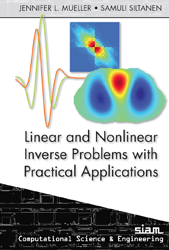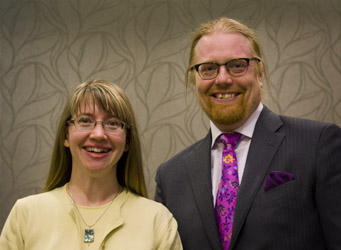Inverse Problems Book Page
Inverse Problems Book Page
This page contains the computational Matlab files related to the book
Linear and Nonlinear Inverse Problems with Practical Applications
written by Jennifer Mueller and Samuli Siltanen and published by SIAM in 2012.
You can order the book at the SIAM webshop.


Using the codes requires some familiarity with the Matlab software. Also, some
routines make use of Matlab toolboxes (image processing toolbox in the case
of X-ray tomography codes, optimization toolbox for total variation regularization
for the 1D deconvolution, and PDE toolbox in the D-bar method files),
which you should have available in those cases.
These Matlab files will help you get started with computational inversion.
Part I: Linear Inverse Problems
We consider several examples of linear inverse problems: X_ray tomography,
one-dimensional deconvolution, image deblurring, and backward heat equation.
For each example, we show how to construct measurement matrices and how
to reconstruct unknown functions from indirect data corrupted by simulated
noise.
One-dimensional deconvolution
The 1D convolution model has a lot of applications. We show how to simulate
data and invert it using regularized methods on the following page:
Backward heat equation
Going back in time in heat propagation is a notoriously ill-posed problem.
The following page contains algorithms for robust computational inversion:
X-ray tomography
We start with quite explicit computations based on actually constructing the
measurement matrix A for a tomographic application:
X-ray tomography with matrices
Once you are familiar with the above matrix-based approach, it's time to get
more practical. In large-scale imaging, constructing the measurement matrix
A is out of the question because it is too large. Instead, we implement reconstruction
methods that only need to apply the matrix A and its transpose to given vectors.
This in turn can be done using Matlab's Radon.m routine.
Now the stuff gets really interesting: we consider tomographic problems with
sparsely sampled data! You can modify the files further to examine limited-
angle tomography as well.
Matrix-free X-ray tomography with sparse data
Image deblurring
You can apply Tikhonov regularization and approximate total variation regularization
to two-dimensional deconvolution problems using the routines on the following page:
Part II: Nonlinear Inverse Problems
The guiding example of Part II is electrical impedance tomography. We show
how to simulate the Dirichlet-to-Neumann map using the Finite Element Method
and how to recover the conductivity using the D-bar method.
We discuss the following two examples:
EIT with the D-bar method: smooth and radial case
EIT with the D-bar method: discontinuous heart-and-lungs phantom